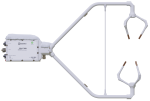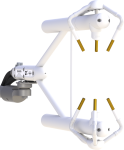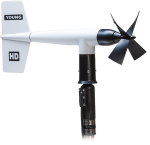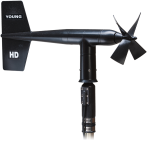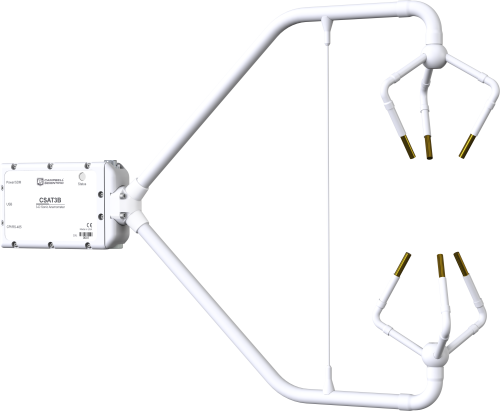
フラックスやその他の乱流研究プロジェクト向けに設計






概要
-
データロガー SDM コマンド
-
データロガー CPI コマンド
-
CSAT3B 内部クロック
SDMプロトコルとCPIプロトコルはどちらも、複数の CSAT3B を同期するためのメカニズムをサポートします。
利点と特徴
- 新しいコンフォーマルコーティングが腐食環境での音波トランスデューサーの保護に貢献
- 一体型エレクトロニクスにより、ハードウェアの取り付けが容易
- 傾斜計を内蔵
- 乱流や渦相関法研究に最適な高精度測定
- センサーアームの両端近くに薄型の空気力学的支持支柱を取り付けた改良型デザインにより、剛性を高め、音波温度の精度を向上
- データロガーのサンプリングは、1~100Hzの任意の周波数に対応
- 新しいCPI通信により、より堅牢で高帯域幅の測定が可能に
- SDM、CPI、USB、RS-485を含む複数の通信オプション
- 簡単に交換できる乾燥剤による内部温湿度測定データ出力を計算するためのバージョン5アルゴリズム;
- バージョン3の信号感度とバージョン4の雨性能を統合
- 非エイリアススペクトルの解析が必要なアプリケーション向けに高周波をフィルタリングするオプションを含む
イメージ



CAD ファイル:
仕様
| センサ | 3次元超音波風速計 |
| 測定の説明 | 最高品質の風速と風向 |
| 動作温度範囲 | -40 ~ +50°C (音速305~368 m s-1に相当) |
| 出力 | ux, uy, uz, Ts 「(ux、uy、uzは風速計の軸を基準とした風の成分です。Tsは摂氏での音速温度です。)」 |
| 信号タイプ/出力 | SDM, CPI, USB, RS-485 |
| 音速 | 3 つの音響経路から決定されます。 (横風の影響を補正) |
| 風向範囲 | CSAT3B座標系で2.5~357.5度 (0~360°カスタマイズ可能) |
| 範囲 | ± 65 m s–1 (本格的な風) |
| フィルタ帯域幅 | 5, 10, 25 Hz |
| 測定経路長 | 「縦 10.0 cm (3.9 インチ)、横 5.8 cm (2.3 インチ)」 |
| 水平からのトランスデューサ角度 | 60度 |
| IP等級 | IP67 |
| トランスデューサ直径 | 0.64 cm (0.25 in.) |
| トランスデューサ取り付けアーム直径 | 0.84 cm (0.33 in.) |
| サポートアーム直径 | 1.59 cm (0.63 in.) |
| 風速計ヘッド重量 | 1.45 kg (3.2 lb) |
| 風速計の寸法 | 60.64 x 12.2 x 43.0 cm (23.87 x 4.8 x 16.9 in.) |
風の正確度 |
|
| -注意- |
精度仕様では以下を前提としています:
|
| 最大オフセット誤差 | < ±8.0 cm s-1 (ux, uy), < ±4.0 cm s-1 (uz) |
| 最大ゲイン誤差 |
|
測定分解能 |
|
| ux, uy | 1 mm s-1 rms |
| uz | 0.5 mm s-1 rms |
| Ts | 0.002°C RMS (@ 25°C) |
| 風向 | < 0.058° (ux = uy ≤ 1 m s-1) |
測定レート |
|
| データロガートリガー | 1 ~ 100 Hz |
| プロンプトなしの出力(PC へ) | 10, 20, 50, 100 Hz |
| 内部自己トリガーレート | 100 Hz |
測定遅延 |
|
| データロガートリガー(フィルターなし) | 1 トリガー期間 (1スキャン間隔) |
| プロンプトなしの出力(フィルターなし) | 10 ms |
| フィルタリングされた出力(データロガーからのプロンプトまたは PC へのプロンプトなし) |
|
内部モニタ測定 |
|
| 更新レート | 2 Hz |
| 傾斜計の正確度 | ±1° |
| 相対湿度計の正確度 |
|
| ボード温度正確度 | ±2°C |
SDM |
|
| -注意- | データロガーベースのデータ取得に使用されます。 |
| ビット周期 | 10 µs ~ 1 ms |
| ケーブル長 |
|
| アドレス範囲 | 1 ~ 14 |
| サンプルあたりのバスクロック | ~200 |
CPI |
|
| -注意- | データロガーベースのデータ取得に使用されます。 |
| ボーレート | 50 kbps ~ 1 Mbps |
| ケーブル長 |
|
| アドレス範囲 | 1 ~ 120 |
| サンプルあたりのバスクロック | ~300 |
RS-485 |
|
| -注意- | 本体設定または PC ベースのデータ取得に使用されます。 |
| ボーレート | 9.6 kbps ~ 115.2 kbps |
| ケーブル長 |
|
| サンプルあたりのバスクロック | ~500 (ASCII形式) |
USB |
|
| -注意- | 本体設定または PC ベースのデータ取得に使用されます。 |
| 接続速度 | USB 2.0 フルスピード 12 Mbps |
| ケーブル長 | 最大5 m (16.4 ft) |
電源/消費電流 |
|
| 電圧供給 | 9.5 ~ 32 Vdc |
| 10 Hz 測定レートでの消費電流 |
|
| 100 Hz 測定レートでの消費電流 |
|
ドキュメント
コンプライアンス
動画とチュートリアル
ダウンロード
CSAT3B Example Programs v.1 (4 kB) 20-10-2020
Three example programs.
Simple SDM Program: SDM communications are used to collect data from a single CSAT3B.
Simple CPI Program: CPI communications are used to collect data from a single CSAT3B.
Advanced CPI Program: A single CSAT3B is properly configured and CPI communications are used to collect the data.
CPI Calculator v.1.0 (2.49 MB) 06-07-2016
The CPI Calculator is a downloadable Microsoft Excel spreadsheet used to estimate the usage and capacity of a CPI network. The calculator provides an overview on CPI devices including the CDM-A108, CDM-A116, CDM-VW300, CDM-VW305, and the CSAT3B. The calculator can also estimate the measurement speed of the CDM-A108 and CDM-A116 based on the number of channels and measurement parameters.
The CPI Calculator is an estimation tool and will help you better understand and design CPI networks by considering the following:
- What is the capability of each CDM or CPI device
- What is the CPI network capacity
- How much of the CPI capacity are the CDMs or CPI devices using
よくある質問
CSAT3Bに関するよくある質問の数: 16
すべて展開すべて折りたたむ
-
いいえ。オフセットは温度と時間の関数です。年に一度、T3CSAT3B の取扱説明書に記載されている手順を使用して、音波風速計の風オフセットを抜き取り検査してください。測定されたオフセットが仕様外の場合は、校正のためにセンサを工場に返送してください。返品承認 (RMA) 番号をリクエストするには、修理と校正のページに記載されている手順に従ってください。
-
はい。CSAT3B および CSAT3BH の測定周波数は、ユーザーが変更できます。ユーザーは、プロンプト付きまたはプロンプトなしの出力レートを選択できます。プロンプト付き出力レートは、データロガーのスキャン間隔に基づいており、整数である必要があります。したがって、サポートされる測定周波数は、1、2、4、5、8、10、20、25、40、50、および 100 Hz になります。許可されるプロンプトなしの出力レートは、10、20、50、および 100 Hz です。
-
CSAT3A または CSAT3B は、-30° ~ +50°C の温度範囲で校正されています。音波風速計の動作温度範囲は、-40° ~ +40°C の範囲をカバーするために 10 度シフトできます。低温アプリケーションの場合は、当社の音波風速計の加熱バージョンを検討する方が適切かもしれません。
機器は、信号が弱くなりすぎるまで校正された温度範囲外で動作し続けます。ただし、校正ファイルは指定された温度範囲のみを対象としているため、適切な校正は測定に適用されません。
-
Campbell Scientific では、音波風速計センサ ヘッドを簡単かつ頻繁に配置できる取り付けブームやハードウェアは提供していません。このタイプのハードウェアはユーザーが用意する必要があります。
-
CSAT3A、CSAT3AH、CSAT3B、および CSAT3BH は、トランスデューサの遅延が風速に与える影響、および程度は低いものの音速測定への影響について、温度に対して較正されています。
超音波風速計には NIST 追跡可能な規格はありません。
-
はい。マッチング層が破損または欠落している場合は、修理のために音波風速計を工場に返送してください。修理および校正ページに記載されている手順に従って、返品承認 (RMA) 番号をリクエストしてください。
-
いいえ。音波風速計は風の測定値とともに時間を報告しません。風データには、データロガーまたは PC などのデータ収集システムによってタイムスタンプが割り当てられます。
-
CSAT3A、CSAT3AH、CSAT3B、CSAT3BH は、他の音波風速計と同様に、超音波信号を使用して音波経路に沿った風速を測定します。塩水噴霧によって音波経路が遮断されると、音波風速計は測定できなくなります。トランスデューサの表面に厚い塩の層が堆積した場合も同様です。
-
超音波風速計は、音波の経路がブロックされている場合は測定できません。経路は、トランスデューサの下部面に溜まった水や、トランスデューサの上部から垂れ下がった水滴によってブロックされることがあります。すべての超音波に付属しているソニック ウィックをトランスデューサに取り付けると、トランスデューサの表面から水分を吸い取ることができます。寒冷時には、ウィックの周囲に氷が積もらないように、必ずこのウィックを取り外してください。
ケーススタディ
概要 地球上で最も過酷で住みにくい環境の一つであるUAEのエンプティ・クォーター砂漠の中心部において、エミレーツ・テック(ETech)は画期的な環境研究の実現に極めて重要な役割を果たしました。2022年夏に開始された風力砂実験(WISE)フェーズ1は、乾燥気候における風成作用に関する科学的理解を深めることを目指しています。WISE実験は、UAEのハリーファ大学と連邦原子力規制庁(FANR)の支援を受けています。ETechは、この研究を可能にした環境モニタリングシステムの設計、導入、保守を行う技術パートナーとして選ばれました。 課題 WISE プロジェクトは、ルブアルハリ砂漠 (空の四分の一) の奥深くに位置しており、次のような環境で知られています。 極限の状況- 日中の灼熱の気温、移動する砂丘、強力な砂嵐、そして強烈な太陽放射 科学的複雑さ- 気象、土壌、エアロゾルパラメータの継続的かつ高解像度の測定の必要性 遠隔展開- 機器の故障に対する余裕がほとんどなく、メンテナンスのためのアクセスも限られている プロジェクトの成功は、自然環境に耐え、継続的に高品質のデータを提供できる、堅牢で信頼性の高い計測機器を維持することにかかっていました。 解決策 プロジェクトの厳しい要求を満たすために、ETech は、過酷な環境で実証済みのパフォーマンスを理由に選ばれた Campbell Scientific の計測機器スイートに基づくターンキー監視システムを設計し、導入しました。 提供され使用された主な機器は次のとおりです。 システムのデータ収集と制御のバックボーンとなる2台のCR1000X計測制御データロガー 砂漠の奥深くから遠隔データ伝送を可能にしたCELL215セルラーモジュール1台 大気の電界状態を監視するために使用されたCS110電界計センサー1台 複数の観測所で風速と風向を測定した5台のWindSonic1超音波風速計 詳細な風の乱れの測定を提供するCSAT3B 3Dソニック風速計1台 周囲温度と表面温度を正確に監視する6つの107温度プローブ......続きを読む
記事とプレスリリース
ブログ記事
-
Why Should You Use a Heated Sonic Anemometer?

19-11-2019 著者: Robin Deissinger
ニュースレター記事
Privacy Policy Update
We've updated our privacy policy. 詳細はこちら
Cookie Consent
Update your cookie preferences. クッキーの設定を更新する
